Vodafone Company: Business Strategy and Macro Environment Analysis
VerifiedAdded on 2020/06/03
|21
|4110
|248
Report
AI Summary
This report provides a detailed analysis of Vodafone's business strategy, focusing on its macro environment and organizational capabilities. It begins with an introduction to business strategy models, including PESTEL analysis for the macro environment and VRIO/VRIN model for internal resource evaluation. The report examines political, economic, social, technological, environmental, and legal factors influencing Vodafone. It also applies Ansoff's growth matrix to explore market penetration, product development, market development, and diversification strategies. The analysis includes an assessment of Vodafone's strengths and weaknesses, as well as an evaluation of the telecommunication sector and the application of Bowman's strategy clock model. The report concludes with strategic recommendations for Vodafone to maintain and improve its market position, emphasizing the importance of adapting to changing customer needs and leveraging organizational capabilities for competitive advantage. The report also includes tables and diagrams to support the analysis and provide clear visual representations of the concepts discussed.
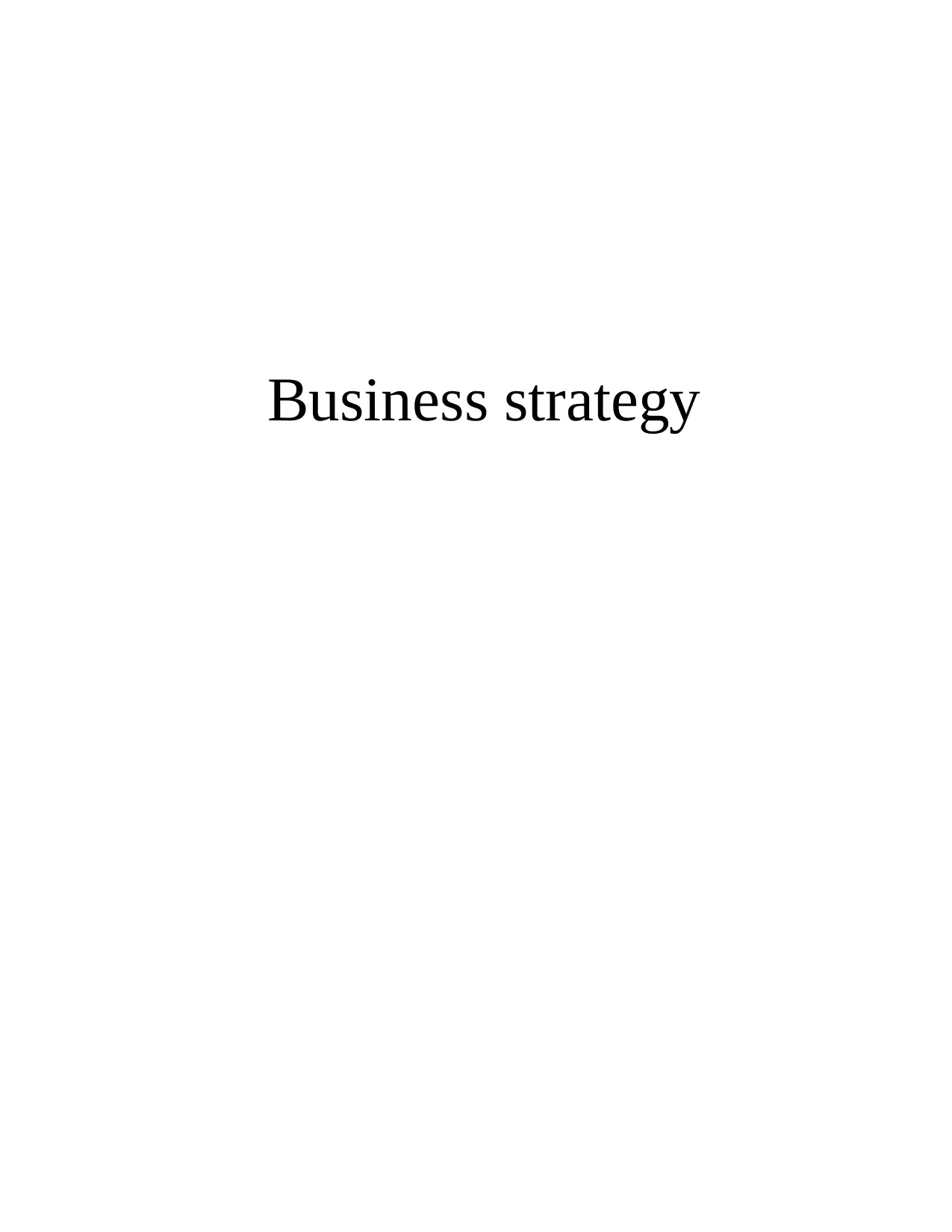
Business strategy
Paraphrase This Document
Need a fresh take? Get an instant paraphrase of this document with our AI Paraphraser

Table of Contents
INTRODUCTION........................................................................................................................................3
Task 1.......................................................................................................................................................3
P1 Impact and influence of macro environment ...............................................................................3
M1 critically analysis of macro environment .....................................................................................7
TASK 2......................................................................................................................................................7
P2 internal environment and organizational capabilities: .................................................................7
M2 critically evaluation of strengths and weaknesses : ...................................................................10
TASK 3....................................................................................................................................................11
P3 ANALYSIS OF TELECOMMUNICATION SECTOR.............................................................................11
M3 dividing of appropriate strategy : ..............................................................................................14
Vodafone company is making strategy to gain edge and maintain its position in the market. By
introducing new and creative ideas in the existing product can provide high profitability of margin.
..........................................................................................................................................................14
Task 4 ....................................................................................................................................................14
P4 Bowman's strategy clock model :.................................................................................................14
M4 producing strategic management plan :.....................................................................................16
CONCLUSION .........................................................................................................................................16
REFERENCES ..........................................................................................................................................17
INTRODUCTION........................................................................................................................................3
Task 1.......................................................................................................................................................3
P1 Impact and influence of macro environment ...............................................................................3
M1 critically analysis of macro environment .....................................................................................7
TASK 2......................................................................................................................................................7
P2 internal environment and organizational capabilities: .................................................................7
M2 critically evaluation of strengths and weaknesses : ...................................................................10
TASK 3....................................................................................................................................................11
P3 ANALYSIS OF TELECOMMUNICATION SECTOR.............................................................................11
M3 dividing of appropriate strategy : ..............................................................................................14
Vodafone company is making strategy to gain edge and maintain its position in the market. By
introducing new and creative ideas in the existing product can provide high profitability of margin.
..........................................................................................................................................................14
Task 4 ....................................................................................................................................................14
P4 Bowman's strategy clock model :.................................................................................................14
M4 producing strategic management plan :.....................................................................................16
CONCLUSION .........................................................................................................................................16
REFERENCES ..........................................................................................................................................17

Illustration Index
Illustration 1: Ansoff's growth.................................................................................................................
Illustration 2: Bowman Strategies of clock Model...................................................................................
Illustration 1: Ansoff's growth.................................................................................................................
Illustration 2: Bowman Strategies of clock Model...................................................................................
⊘ This is a preview!⊘
Do you want full access?
Subscribe today to unlock all pages.

Trusted by 1+ million students worldwide
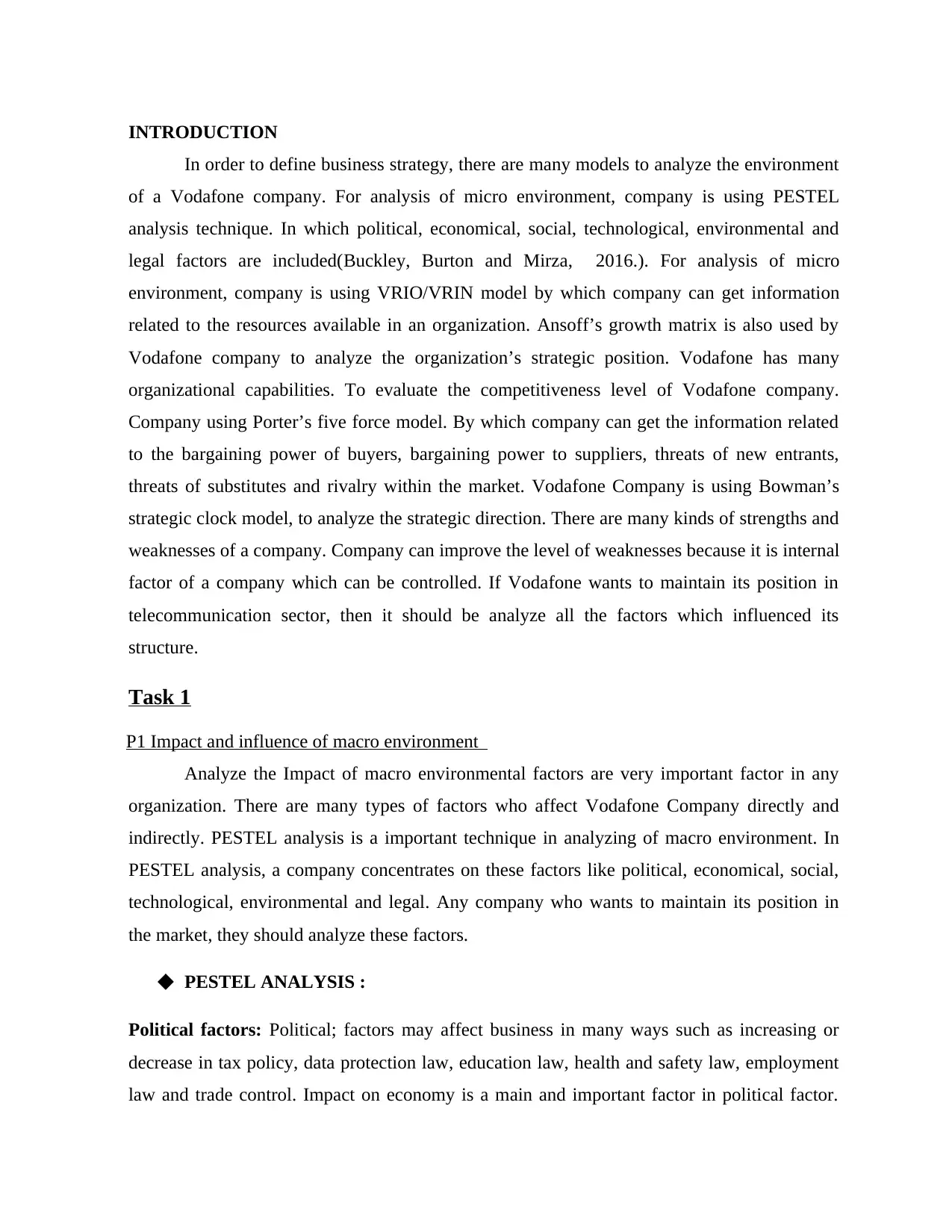
INTRODUCTION
In order to define business strategy, there are many models to analyze the environment
of a Vodafone company. For analysis of micro environment, company is using PESTEL
analysis technique. In which political, economical, social, technological, environmental and
legal factors are included(Buckley, Burton and Mirza, 2016.). For analysis of micro
environment, company is using VRIO/VRIN model by which company can get information
related to the resources available in an organization. Ansoff’s growth matrix is also used by
Vodafone company to analyze the organization’s strategic position. Vodafone has many
organizational capabilities. To evaluate the competitiveness level of Vodafone company.
Company using Porter’s five force model. By which company can get the information related
to the bargaining power of buyers, bargaining power to suppliers, threats of new entrants,
threats of substitutes and rivalry within the market. Vodafone Company is using Bowman’s
strategic clock model, to analyze the strategic direction. There are many kinds of strengths and
weaknesses of a company. Company can improve the level of weaknesses because it is internal
factor of a company which can be controlled. If Vodafone wants to maintain its position in
telecommunication sector, then it should be analyze all the factors which influenced its
structure.
Task 1
P1 Impact and influence of macro environment
Analyze the Impact of macro environmental factors are very important factor in any
organization. There are many types of factors who affect Vodafone Company directly and
indirectly. PESTEL analysis is a important technique in analyzing of macro environment. In
PESTEL analysis, a company concentrates on these factors like political, economical, social,
technological, environmental and legal. Any company who wants to maintain its position in
the market, they should analyze these factors.
PESTEL ANALYSIS :
Political factors: Political; factors may affect business in many ways such as increasing or
decrease in tax policy, data protection law, education law, health and safety law, employment
law and trade control. Impact on economy is a main and important factor in political factor.
In order to define business strategy, there are many models to analyze the environment
of a Vodafone company. For analysis of micro environment, company is using PESTEL
analysis technique. In which political, economical, social, technological, environmental and
legal factors are included(Buckley, Burton and Mirza, 2016.). For analysis of micro
environment, company is using VRIO/VRIN model by which company can get information
related to the resources available in an organization. Ansoff’s growth matrix is also used by
Vodafone company to analyze the organization’s strategic position. Vodafone has many
organizational capabilities. To evaluate the competitiveness level of Vodafone company.
Company using Porter’s five force model. By which company can get the information related
to the bargaining power of buyers, bargaining power to suppliers, threats of new entrants,
threats of substitutes and rivalry within the market. Vodafone Company is using Bowman’s
strategic clock model, to analyze the strategic direction. There are many kinds of strengths and
weaknesses of a company. Company can improve the level of weaknesses because it is internal
factor of a company which can be controlled. If Vodafone wants to maintain its position in
telecommunication sector, then it should be analyze all the factors which influenced its
structure.
Task 1
P1 Impact and influence of macro environment
Analyze the Impact of macro environmental factors are very important factor in any
organization. There are many types of factors who affect Vodafone Company directly and
indirectly. PESTEL analysis is a important technique in analyzing of macro environment. In
PESTEL analysis, a company concentrates on these factors like political, economical, social,
technological, environmental and legal. Any company who wants to maintain its position in
the market, they should analyze these factors.
PESTEL ANALYSIS :
Political factors: Political; factors may affect business in many ways such as increasing or
decrease in tax policy, data protection law, education law, health and safety law, employment
law and trade control. Impact on economy is a main and important factor in political factor.
Paraphrase This Document
Need a fresh take? Get an instant paraphrase of this document with our AI Paraphraser
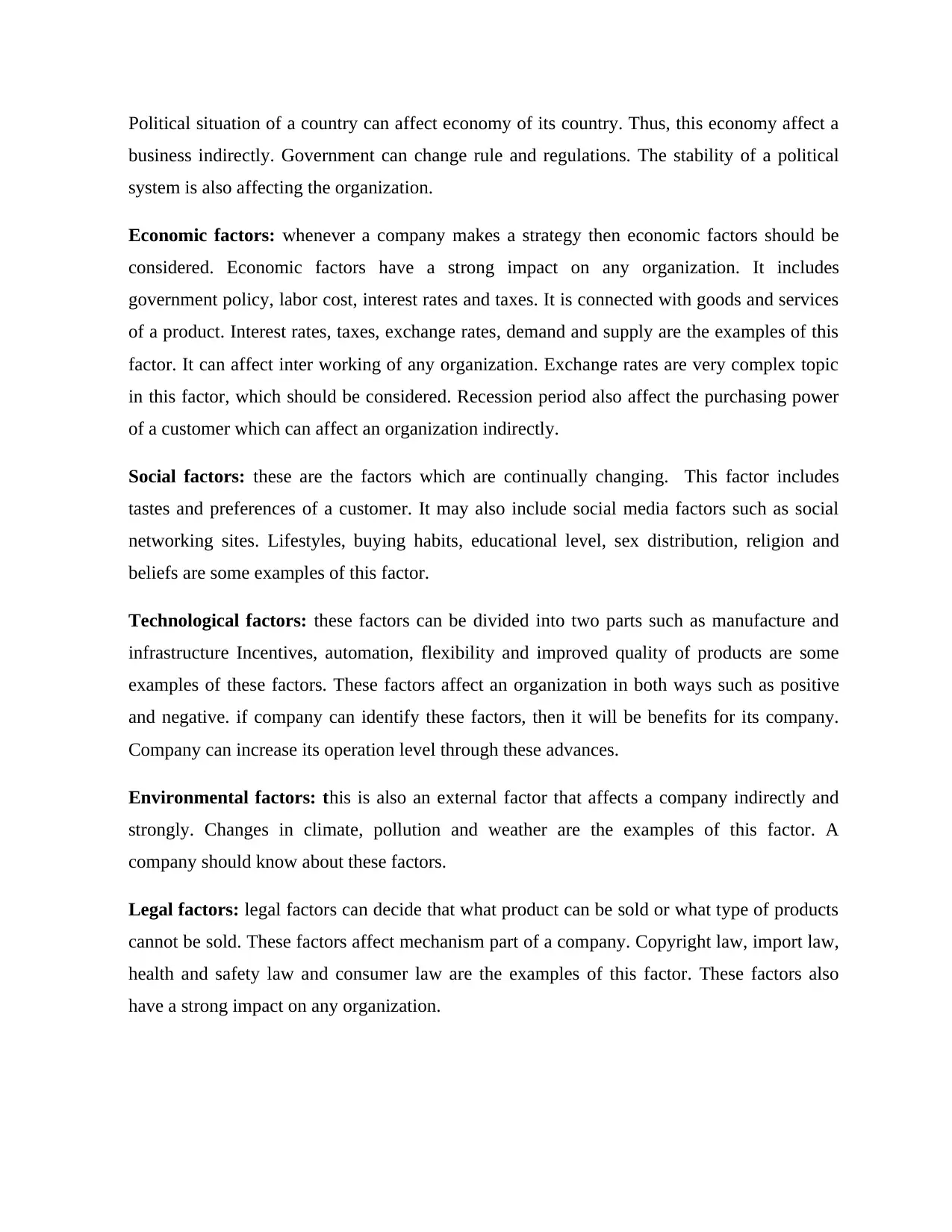
Political situation of a country can affect economy of its country. Thus, this economy affect a
business indirectly. Government can change rule and regulations. The stability of a political
system is also affecting the organization.
Economic factors: whenever a company makes a strategy then economic factors should be
considered. Economic factors have a strong impact on any organization. It includes
government policy, labor cost, interest rates and taxes. It is connected with goods and services
of a product. Interest rates, taxes, exchange rates, demand and supply are the examples of this
factor. It can affect inter working of any organization. Exchange rates are very complex topic
in this factor, which should be considered. Recession period also affect the purchasing power
of a customer which can affect an organization indirectly.
Social factors: these are the factors which are continually changing. This factor includes
tastes and preferences of a customer. It may also include social media factors such as social
networking sites. Lifestyles, buying habits, educational level, sex distribution, religion and
beliefs are some examples of this factor.
Technological factors: these factors can be divided into two parts such as manufacture and
infrastructure Incentives, automation, flexibility and improved quality of products are some
examples of these factors. These factors affect an organization in both ways such as positive
and negative. if company can identify these factors, then it will be benefits for its company.
Company can increase its operation level through these advances.
Environmental factors: this is also an external factor that affects a company indirectly and
strongly. Changes in climate, pollution and weather are the examples of this factor. A
company should know about these factors.
Legal factors: legal factors can decide that what product can be sold or what type of products
cannot be sold. These factors affect mechanism part of a company. Copyright law, import law,
health and safety law and consumer law are the examples of this factor. These factors also
have a strong impact on any organization.
business indirectly. Government can change rule and regulations. The stability of a political
system is also affecting the organization.
Economic factors: whenever a company makes a strategy then economic factors should be
considered. Economic factors have a strong impact on any organization. It includes
government policy, labor cost, interest rates and taxes. It is connected with goods and services
of a product. Interest rates, taxes, exchange rates, demand and supply are the examples of this
factor. It can affect inter working of any organization. Exchange rates are very complex topic
in this factor, which should be considered. Recession period also affect the purchasing power
of a customer which can affect an organization indirectly.
Social factors: these are the factors which are continually changing. This factor includes
tastes and preferences of a customer. It may also include social media factors such as social
networking sites. Lifestyles, buying habits, educational level, sex distribution, religion and
beliefs are some examples of this factor.
Technological factors: these factors can be divided into two parts such as manufacture and
infrastructure Incentives, automation, flexibility and improved quality of products are some
examples of these factors. These factors affect an organization in both ways such as positive
and negative. if company can identify these factors, then it will be benefits for its company.
Company can increase its operation level through these advances.
Environmental factors: this is also an external factor that affects a company indirectly and
strongly. Changes in climate, pollution and weather are the examples of this factor. A
company should know about these factors.
Legal factors: legal factors can decide that what product can be sold or what type of products
cannot be sold. These factors affect mechanism part of a company. Copyright law, import law,
health and safety law and consumer law are the examples of this factor. These factors also
have a strong impact on any organization.

Vodafone should know about these all factors to maintain its position in the market. Macro
environment means a broad area which includes all these factors and these factors can be
analyzed by pestel techniques. It is the best and important technique for any organization.
Using ansoff’s growth vector matrix:
It can be called by ansoff’s product market growth matrix. This matrix helps in provide ideas
about how to grow a business and how to gain profitability. Commonly it can be divide into
two parts such as current products or new products and current market and new market. In this
model, Vodafone can use these four types of strategy such as:
Market penetration strategy
Product development strategy
Market development strategy
Diversification
This model can be explained by this diagram :
Illustration 1: Ansoff's growth
(Source: Ansoff Matrix, 2016)
environment means a broad area which includes all these factors and these factors can be
analyzed by pestel techniques. It is the best and important technique for any organization.
Using ansoff’s growth vector matrix:
It can be called by ansoff’s product market growth matrix. This matrix helps in provide ideas
about how to grow a business and how to gain profitability. Commonly it can be divide into
two parts such as current products or new products and current market and new market. In this
model, Vodafone can use these four types of strategy such as:
Market penetration strategy
Product development strategy
Market development strategy
Diversification
This model can be explained by this diagram :
Illustration 1: Ansoff's growth
(Source: Ansoff Matrix, 2016)
⊘ This is a preview!⊘
Do you want full access?
Subscribe today to unlock all pages.

Trusted by 1+ million students worldwide
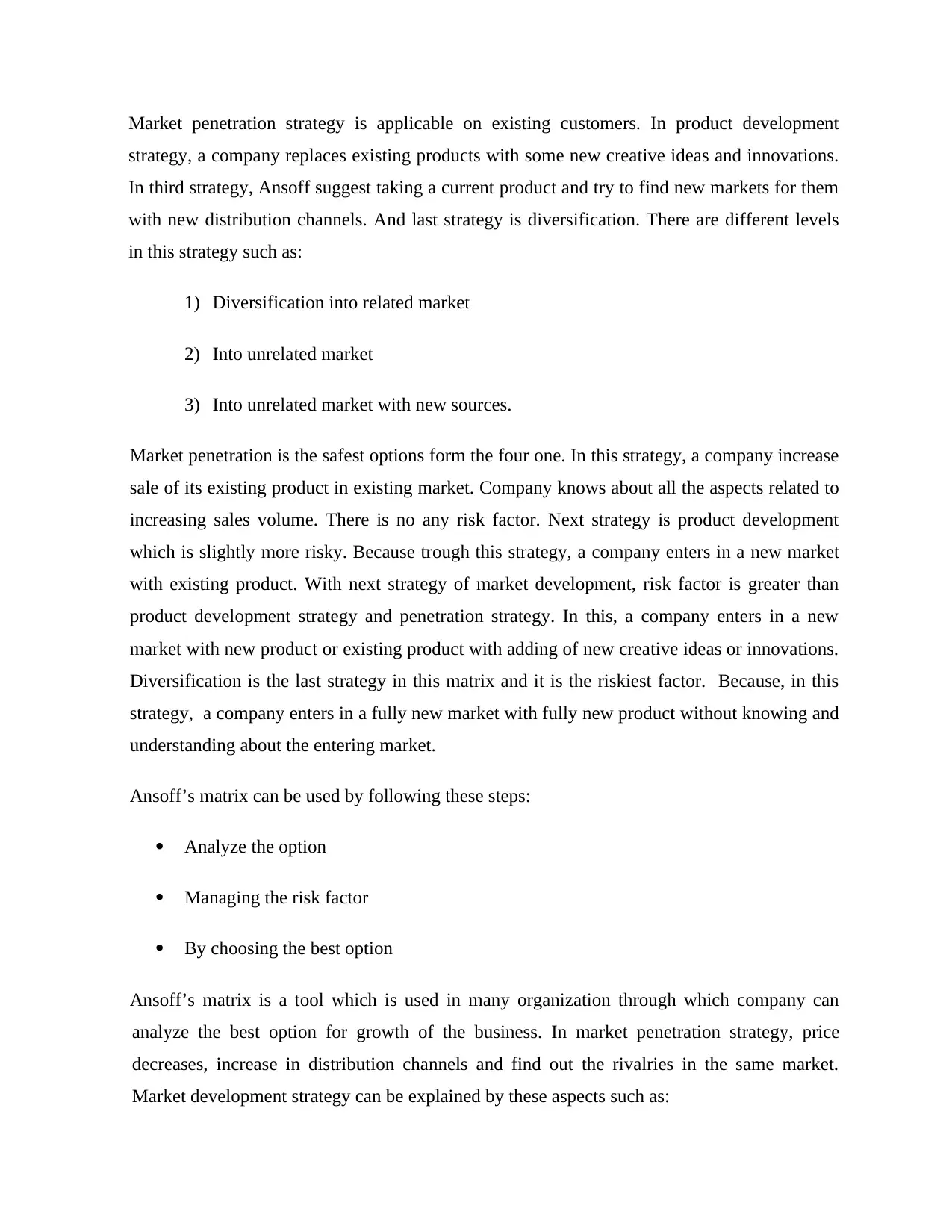
Market penetration strategy is applicable on existing customers. In product development
strategy, a company replaces existing products with some new creative ideas and innovations.
In third strategy, Ansoff suggest taking a current product and try to find new markets for them
with new distribution channels. And last strategy is diversification. There are different levels
in this strategy such as:
1) Diversification into related market
2) Into unrelated market
3) Into unrelated market with new sources.
Market penetration is the safest options form the four one. In this strategy, a company increase
sale of its existing product in existing market. Company knows about all the aspects related to
increasing sales volume. There is no any risk factor. Next strategy is product development
which is slightly more risky. Because trough this strategy, a company enters in a new market
with existing product. With next strategy of market development, risk factor is greater than
product development strategy and penetration strategy. In this, a company enters in a new
market with new product or existing product with adding of new creative ideas or innovations.
Diversification is the last strategy in this matrix and it is the riskiest factor. Because, in this
strategy, a company enters in a fully new market with fully new product without knowing and
understanding about the entering market.
Ansoff’s matrix can be used by following these steps:
Analyze the option
Managing the risk factor
By choosing the best option
Ansoff’s matrix is a tool which is used in many organization through which company can
analyze the best option for growth of the business. In market penetration strategy, price
decreases, increase in distribution channels and find out the rivalries in the same market.
Market development strategy can be explained by these aspects such as:
strategy, a company replaces existing products with some new creative ideas and innovations.
In third strategy, Ansoff suggest taking a current product and try to find new markets for them
with new distribution channels. And last strategy is diversification. There are different levels
in this strategy such as:
1) Diversification into related market
2) Into unrelated market
3) Into unrelated market with new sources.
Market penetration is the safest options form the four one. In this strategy, a company increase
sale of its existing product in existing market. Company knows about all the aspects related to
increasing sales volume. There is no any risk factor. Next strategy is product development
which is slightly more risky. Because trough this strategy, a company enters in a new market
with existing product. With next strategy of market development, risk factor is greater than
product development strategy and penetration strategy. In this, a company enters in a new
market with new product or existing product with adding of new creative ideas or innovations.
Diversification is the last strategy in this matrix and it is the riskiest factor. Because, in this
strategy, a company enters in a fully new market with fully new product without knowing and
understanding about the entering market.
Ansoff’s matrix can be used by following these steps:
Analyze the option
Managing the risk factor
By choosing the best option
Ansoff’s matrix is a tool which is used in many organization through which company can
analyze the best option for growth of the business. In market penetration strategy, price
decreases, increase in distribution channels and find out the rivalries in the same market.
Market development strategy can be explained by these aspects such as:
Paraphrase This Document
Need a fresh take? Get an instant paraphrase of this document with our AI Paraphraser

1) Different customers
2) New areas
3) Foreign markets
This strategy is being successful when a company introduce new product with unique
technology.
Ansoff's strategy with example :
Illustration 2: ansoff's matrix
Source : Ansoff's matrix, 2016 <http://www.business-to-you.com/ansoff-matrix-
grow-business/>
Company can use penetration market strategy in which it can sell more existing products in
existing market. In product development company can launch new products in existing market.
In market development, company can launch new product in new market to grow its sales
volum. It can consider all the urban area as well. Company can diversify its existing product
and existing market to new product and new market.
2) New areas
3) Foreign markets
This strategy is being successful when a company introduce new product with unique
technology.
Ansoff's strategy with example :
Illustration 2: ansoff's matrix
Source : Ansoff's matrix, 2016 <http://www.business-to-you.com/ansoff-matrix-
grow-business/>
Company can use penetration market strategy in which it can sell more existing products in
existing market. In product development company can launch new products in existing market.
In market development, company can launch new product in new market to grow its sales
volum. It can consider all the urban area as well. Company can diversify its existing product
and existing market to new product and new market.
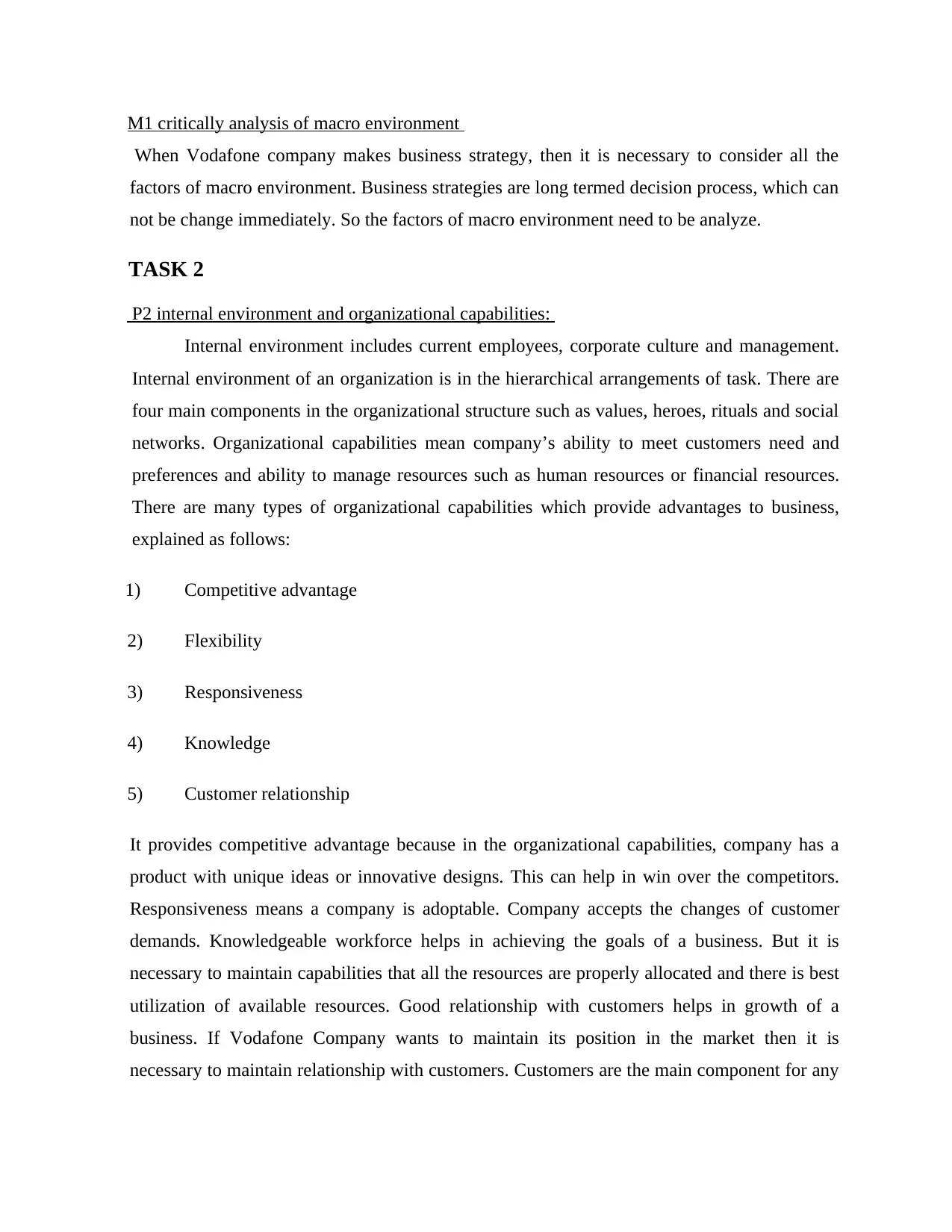
M1 critically analysis of macro environment
When Vodafone company makes business strategy, then it is necessary to consider all the
factors of macro environment. Business strategies are long termed decision process, which can
not be change immediately. So the factors of macro environment need to be analyze.
TASK 2
P2 internal environment and organizational capabilities:
Internal environment includes current employees, corporate culture and management.
Internal environment of an organization is in the hierarchical arrangements of task. There are
four main components in the organizational structure such as values, heroes, rituals and social
networks. Organizational capabilities mean company’s ability to meet customers need and
preferences and ability to manage resources such as human resources or financial resources.
There are many types of organizational capabilities which provide advantages to business,
explained as follows:
1) Competitive advantage
2) Flexibility
3) Responsiveness
4) Knowledge
5) Customer relationship
It provides competitive advantage because in the organizational capabilities, company has a
product with unique ideas or innovative designs. This can help in win over the competitors.
Responsiveness means a company is adoptable. Company accepts the changes of customer
demands. Knowledgeable workforce helps in achieving the goals of a business. But it is
necessary to maintain capabilities that all the resources are properly allocated and there is best
utilization of available resources. Good relationship with customers helps in growth of a
business. If Vodafone Company wants to maintain its position in the market then it is
necessary to maintain relationship with customers. Customers are the main component for any
When Vodafone company makes business strategy, then it is necessary to consider all the
factors of macro environment. Business strategies are long termed decision process, which can
not be change immediately. So the factors of macro environment need to be analyze.
TASK 2
P2 internal environment and organizational capabilities:
Internal environment includes current employees, corporate culture and management.
Internal environment of an organization is in the hierarchical arrangements of task. There are
four main components in the organizational structure such as values, heroes, rituals and social
networks. Organizational capabilities mean company’s ability to meet customers need and
preferences and ability to manage resources such as human resources or financial resources.
There are many types of organizational capabilities which provide advantages to business,
explained as follows:
1) Competitive advantage
2) Flexibility
3) Responsiveness
4) Knowledge
5) Customer relationship
It provides competitive advantage because in the organizational capabilities, company has a
product with unique ideas or innovative designs. This can help in win over the competitors.
Responsiveness means a company is adoptable. Company accepts the changes of customer
demands. Knowledgeable workforce helps in achieving the goals of a business. But it is
necessary to maintain capabilities that all the resources are properly allocated and there is best
utilization of available resources. Good relationship with customers helps in growth of a
business. If Vodafone Company wants to maintain its position in the market then it is
necessary to maintain relationship with customers. Customers are the main component for any
⊘ This is a preview!⊘
Do you want full access?
Subscribe today to unlock all pages.

Trusted by 1+ million students worldwide

organization to grow or to maintain position. Relationship with customers can affect business
sales, loyalty and reputation in the market.
VRIO/VRIN model: it is a model to evaluate resources of a company. It can be called
complements of the PESTEL analysis, which is used in every organization to analyze the
macro environment. It is a analytical technique to evaluate resources such as financial
resources, human resources, material resources and non material resources. The dimensions for
this model are as follow:
1) Value
2) Rareness
3) Imitability
4) Organization
Vrio model helps in decision making about the process of internal and external securing
services. Value framework means is this capability valuable to the firm? There are several
attempts, a company can exploit are:
1) Technological
2) Demographically
3) Cultural
4) Economical
5) Political
6) Legal
Value can be defined by the value chain of a company. By Cost of imitation, company can
achieve competitive advantages due to following reasons:
1) Patents
sales, loyalty and reputation in the market.
VRIO/VRIN model: it is a model to evaluate resources of a company. It can be called
complements of the PESTEL analysis, which is used in every organization to analyze the
macro environment. It is a analytical technique to evaluate resources such as financial
resources, human resources, material resources and non material resources. The dimensions for
this model are as follow:
1) Value
2) Rareness
3) Imitability
4) Organization
Vrio model helps in decision making about the process of internal and external securing
services. Value framework means is this capability valuable to the firm? There are several
attempts, a company can exploit are:
1) Technological
2) Demographically
3) Cultural
4) Economical
5) Political
6) Legal
Value can be defined by the value chain of a company. By Cost of imitation, company can
achieve competitive advantages due to following reasons:
1) Patents
Paraphrase This Document
Need a fresh take? Get an instant paraphrase of this document with our AI Paraphraser

2) Social complexity
3) Casual ambiguity
4) Unique historical conditions
Analysis of VRIO model by this table :
RESOURC
ES
VALUE RARITY IMITATE ORGANIZ
ATION
COMPETI
TIVE
IMPLICAT
IONS
STRENGT
HS AND
WEAKNES
SES
Human
resources
low high medium low Temporary
competitive
advantage
weakness
Customer
relationship
high medium medium high Sustained
advantage
strength
Managerial
expertise
medium high low high Temporary
advantage
weakness
Service
level
high low medium low Competitive
advantage
strength
technology high medium high low Competitive
advantage
strength
Strength and weaknesses: Vodafone is a brand known company. There are many kinds of
strengths and weaknesses of this company. These can be identified by SWOT analysis.
Strengths of Vodafone Company are:
3) Casual ambiguity
4) Unique historical conditions
Analysis of VRIO model by this table :
RESOURC
ES
VALUE RARITY IMITATE ORGANIZ
ATION
COMPETI
TIVE
IMPLICAT
IONS
STRENGT
HS AND
WEAKNES
SES
Human
resources
low high medium low Temporary
competitive
advantage
weakness
Customer
relationship
high medium medium high Sustained
advantage
strength
Managerial
expertise
medium high low high Temporary
advantage
weakness
Service
level
high low medium low Competitive
advantage
strength
technology high medium high low Competitive
advantage
strength
Strength and weaknesses: Vodafone is a brand known company. There are many kinds of
strengths and weaknesses of this company. These can be identified by SWOT analysis.
Strengths of Vodafone Company are:
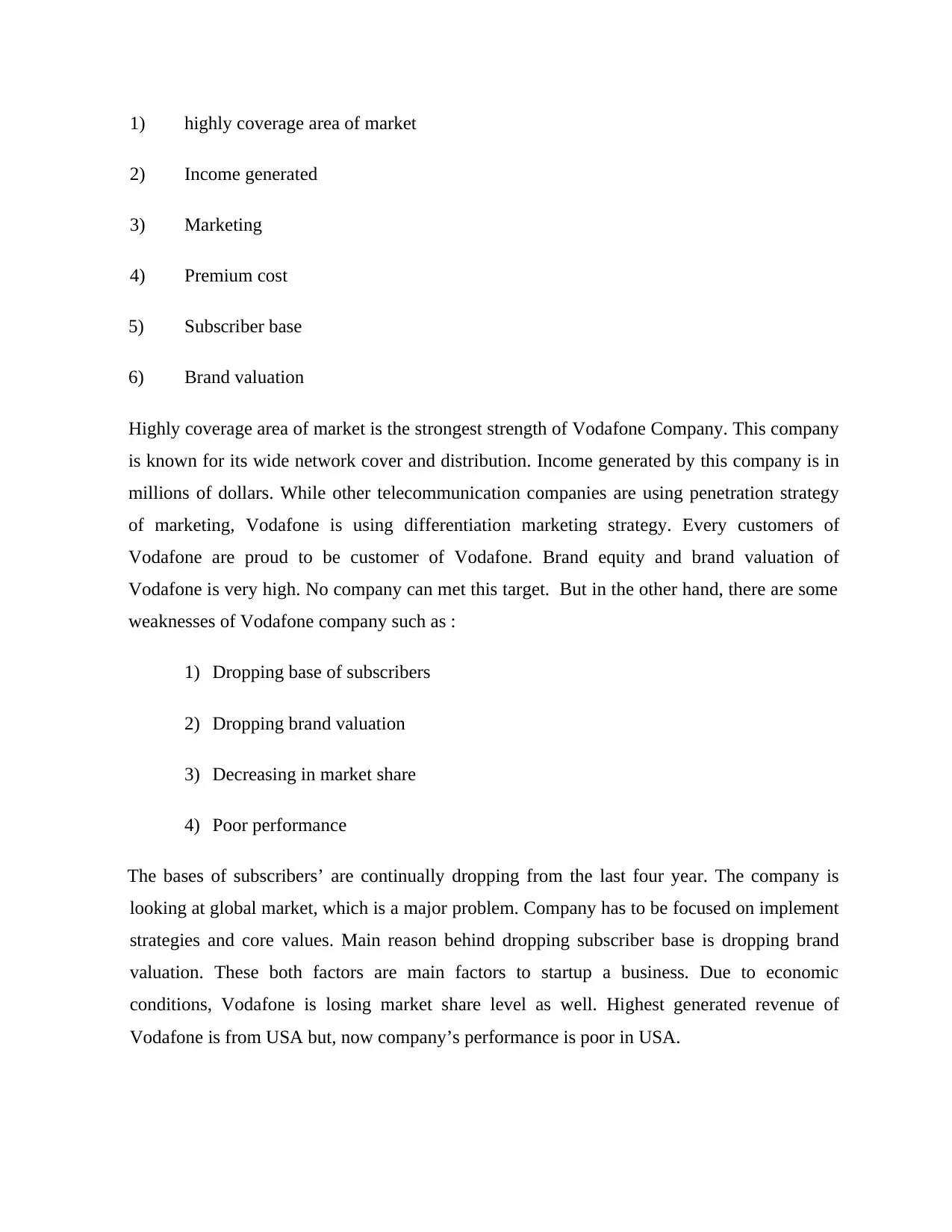
1) highly coverage area of market
2) Income generated
3) Marketing
4) Premium cost
5) Subscriber base
6) Brand valuation
Highly coverage area of market is the strongest strength of Vodafone Company. This company
is known for its wide network cover and distribution. Income generated by this company is in
millions of dollars. While other telecommunication companies are using penetration strategy
of marketing, Vodafone is using differentiation marketing strategy. Every customers of
Vodafone are proud to be customer of Vodafone. Brand equity and brand valuation of
Vodafone is very high. No company can met this target. But in the other hand, there are some
weaknesses of Vodafone company such as :
1) Dropping base of subscribers
2) Dropping brand valuation
3) Decreasing in market share
4) Poor performance
The bases of subscribers’ are continually dropping from the last four year. The company is
looking at global market, which is a major problem. Company has to be focused on implement
strategies and core values. Main reason behind dropping subscriber base is dropping brand
valuation. These both factors are main factors to startup a business. Due to economic
conditions, Vodafone is losing market share level as well. Highest generated revenue of
Vodafone is from USA but, now company’s performance is poor in USA.
2) Income generated
3) Marketing
4) Premium cost
5) Subscriber base
6) Brand valuation
Highly coverage area of market is the strongest strength of Vodafone Company. This company
is known for its wide network cover and distribution. Income generated by this company is in
millions of dollars. While other telecommunication companies are using penetration strategy
of marketing, Vodafone is using differentiation marketing strategy. Every customers of
Vodafone are proud to be customer of Vodafone. Brand equity and brand valuation of
Vodafone is very high. No company can met this target. But in the other hand, there are some
weaknesses of Vodafone company such as :
1) Dropping base of subscribers
2) Dropping brand valuation
3) Decreasing in market share
4) Poor performance
The bases of subscribers’ are continually dropping from the last four year. The company is
looking at global market, which is a major problem. Company has to be focused on implement
strategies and core values. Main reason behind dropping subscriber base is dropping brand
valuation. These both factors are main factors to startup a business. Due to economic
conditions, Vodafone is losing market share level as well. Highest generated revenue of
Vodafone is from USA but, now company’s performance is poor in USA.
⊘ This is a preview!⊘
Do you want full access?
Subscribe today to unlock all pages.

Trusted by 1+ million students worldwide
1 out of 21
Related Documents
Your All-in-One AI-Powered Toolkit for Academic Success.
+13062052269
info@desklib.com
Available 24*7 on WhatsApp / Email
![[object Object]](/_next/static/media/star-bottom.7253800d.svg)
Unlock your academic potential
Copyright © 2020–2025 A2Z Services. All Rights Reserved. Developed and managed by ZUCOL.





